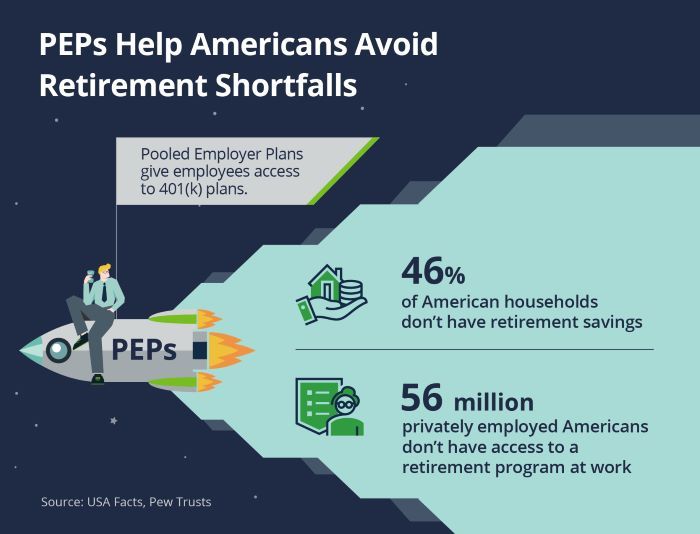Blog
Pooled Employer Plan: An Efficient Alternative to a Traditional 401(k)
Explore how PEP allows companies to avoid liability risks and do right by their HR and Finance teams, as well as their retirement plan participants.
In 2022, less than half (46%) of American households had no savings in retirement accounts.1 Part of the savings shortfall could be lack of access to retirement programs through work, which is the case for 56 million privately employed Americans.2
Access to a 401(k) plan can be an attractive benefit for prospective employees and an effective retention tool for existing ones. Unfortunately, many companies find they don’t have the resources to offer or properly manage a retirement plan.
Managing a retirement plan can be complex and costly, requiring time from the CFO and Human Resources team, while also leaving companies exposed to fiduciary risk. Participating in a pooled employer plan (PEP) allows companies to shift that work and risk to 401(k) management experts while offering employees valuable retirement benefits. A PEP can also potentially save companies money.
To learn more about PEPs and their benefits, watch the webinar below.
What Is a Pooled Employer Plan?
A pooled employer plan allows unrelated businesses to participate in a single 401(k) retirement plan. A consolidated plan means consolidated administration and costs, and less work for each participating company,
Managing and executing a PEP requires three main components:
- A pooled plan provider (PPP), which serves as the plan sponsor, administrator, and fiduciary
- An investment manager that selects and monitors funds while also taking fiduciary responsibility
- A record keeper, which integrates with payroll and provides dashboard access for employees to manage their retirement plans.
Each of these partners takes on the lion’s share of the work related to managing a 401(k) plan. The participating company is responsible for reporting contributions at the end of each pay period and submitting one census file at the end of the year; the PPP is responsible for the rest of the components.
What Are the Benefits of a Pooled Employer Plan?
The benefits of a PEP include:
- Saving time. With a PEP, a company’s CFO and HR professionals are no longer responsible for investment management, record keeping, annual audits, plan compliance, and fielding employee calls and questions. According to an SHRM report, nearly half (42%) of HR professionals say lack of time is their greatest barrier to achieving their organization’s priorities. A PEP allows them to focus on people, finances, and other company priorities.
- Reducing risk. Fiduciary responsibility falls on the PPP and investment manager, instead of the participating employer. This means companies are no longer liable for improper filing, investment management, or record keeping.
- Maintaining consistency. When a company experiences staffing changes, the retirement plan will continue to be managed without disruption.
- Saving money. By participating in a PEP, companies can reduce the administrative costs of their existing retirement plan while benefiting from negotiated plan rates. They also save money by avoiding audit costs, which can range from $10,000 to $20,000.
Employees benefit from:
- Investment management experts who specialize in optimizing plan performance and can offer personalized financial wellness coaching and education.
- A user-friendly experience with simple onboarding at the outset and the ability to make changes quickly and easily after enrollment.
- Ongoing support from the PPP.

Who Should Participate in a Pooled Employer Plan?
Both small and large organizations can benefit from a PEP. Fred Reish, a partner with legal powerhouse Faegre Drinker, says in 5 to 10 years, PEPs will match single employer plans in new plan adoption. It will take time, but it will happen, especially in the small- and mid-sized markets, in which Reish predicts that at least 80% of employers could have their retirement plan needs met by a PEP.
- Small organizations often participate in PEPs because they don’t have adequate resources to manage a retirement plan. Participating in a PEP allows an organization’s HR team or CFO to spend less time on 401(k) management and more time on their core responsibilities. PEPs can also be a good choice for smaller organizations that find the cost of establishing a 401(k) plan prohibitive.
- Medium to large organizations participate in PEPs to save their employees time and to reduce fiduciary risk. If a large organization’s in-house team doesn’t have the time or expertise to manage a retirement program, a PEP can take over those responsibilities. A PEP can also protect companies from being sued for mismanaging the plan, which is of greater concern to large organizations that tend to be targeted because they are perceived to have deep pockets.
How to Get Started
If you’re interested in establishing a PEP, options to look into include:
- Flexible plan design. A pooled employer plan does not have to mean limited design options.
- A plan with an independent PPP, investment manager, and record keeper. Having separate entities manage the three components of a PEP means they hold each other accountable for performance.
- A plan that meets the needs of the employee base. It’s helpful to work with PEP providers that offer an easy-to-use employee interface and financial wellness features that help employees make more informed decisions about their retirement plans.
A PEP allows companies to avoid liability risks and do right by their HR and Finance teams, as well as their retirement plan participants. To learn more, contact a Woodruff Sawyer representative.
1https://usafacts.org/data-projects/retirement-savings
2https://www.pewtrusts.org/en/research-and-analysis/articles/2023/06/01/states-face-334-billion-shortfall-over-20-years-due-to-insufficient-retirement-savings
Author
Table of Contents












